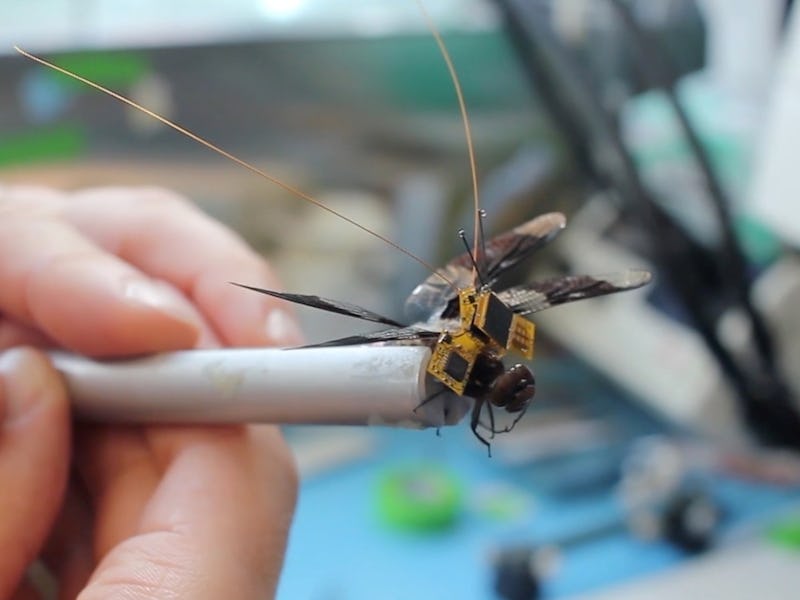Scientists Have Created a Controllable Cyborg Dragonfly
Say hello to genetically modified drones.

A few years ago, researchers found a way to put backpacks on cockroaches and drive them around like little tanks, but these are insects we’re talking about; science was never going to stop at controlling bugs that are stuck on the ground.
Now, just a few years and cutting-edge genetic modifications later, a team of medical researchers has produced an airborne successor to the cockroach drone: the DragonflEye. It’s less DIY-friendly than the roach-tank, but it’s also a far more useful achievement, and it could lead to important to advances in medicine and other topics far beyond the pure world of drones.
“DragonflEye is a totally new kind of micro-aerial vehicle that’s smaller, lighter and stealthier than anything else that’s man-made,” says the study’s principal investigator Jesse J. Wheeler. That’s about the last time you’ll hear the creators talk about DragonflEye as a conventional drone, though. This work comes from the Draper biomedical research group and the Howard Hughes Medical Institute, and while those might seem like odd names to associate with drone research, in this case, they’re really not.
That’s because, in their quest to build a flying insect drone, the team had to build and miniaturize the same kinds of sensors, controllers, and power components that also will go into the surgical implants and medical devices of the future. In particular, to steer DragonflEye like a cockroach, the team had to develop a better and especially smaller way of forcing nerves to fire.
That’s because dragonflies don’t sense the world the same way cockroaches do. Roaches navigate with their antennae, and by stimulating the nerves right on the surface of those antennae it was very easy for researchers to give them the impression they had hit a solid object, and should turn away from it. Dragonflies have no such easily-zapped steering neurons, however, and to convince their little bug-brains that they needed to shy away from an imaginary obstacle on either the left or right, the team had to monkey with the genetics of the insects themselves.
Basically, the researchers used a technique called optogenics, which involves inserting genes into the dragonflies (when they’re still embryos) that cause their neurons to make light-sensitive versions of certain key proteins; in these dragonflies, hitting a neuron with a focused source of UV light will cause the proteins to react as though they had been hit with regular electrical activity, and they in turn cause the neuron to fire. So, by outfitting these genetically-modified dragonflies with remote controlled backpacks that can shoot light onto the appropriate parts of the dragonflies’ sensory systems, you’ve got a much, much more hard-to-make version of cockroach control.
As you might imagine, it’s a pretty hard to put all this fancy remote UV-laser-shooting stuff into a backpack small and light enough for a dragonfly to carry it — and that’s the point. DragonflEye is absolutely intended to be useful on its own merits, which is why the team has loaded its backpack with sensors it can explore and perhaps someday map unknown spaces. However, the primary goal of the project was the achievement itself; if you can put an optogenic backpack on a dragonfly, you can certainly put one on a hard-to-handle part of the human nervous system. Draper has coined the phrase “optrodes” (for optical electrodes) to describe their new tech.
Thanks to CRISPR and related technologies, human beings don’t need to be modified before birth to take advantage of genetic breakthroughs; optogenics will almost certainly be a source of human medical advances in the near future, allowing new treatments for maladies as diverse as paralysis, epilepsy, and even depression. Here we see how advanced the pure-tech side of things has already become, and how ready it is to take on the job of light-starting neurons just as soon as those neurons can be (legally) modified to be light-startable themselves.
Insects can certainly be useful in their own right, and DragonflEye could plausibly be flown into collapsed buildings or other dangerous and confined spaces currently off-limits to quadcopters. Still, the ability to reliably stimulate very specific nerves, in general, could be the far more important achievement. These insect drones are unquestionably cool, but what they really are are flying proofs-of-concept that the most important genetic technologies of tomorrow are more than ready to start affecting real human lives, today.